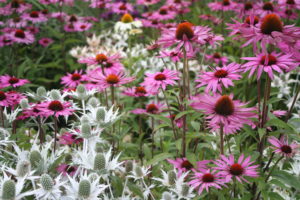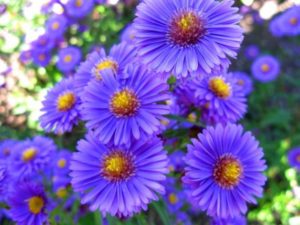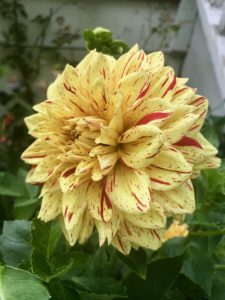SEPTEMBER GARDEN TIPS
September: What to do in the Garden? by Nancy Greeley
Summer annuals are looking bedraggled and I think we’re all looking for something fresh after a long hot, dry summer. I’ve had it with the hot weather and much of my garden has as well. I’m ready for a change of season and sweaters, and for the virus to wane so I can see all of you in person at some not too distant time in the future. There’s always much to be done in the garden.
September is a great time to once again take stock of your garden to see what needs to be moved, divided or added to help you move ever closer to your dream garden. We’re all gardeners, right? To me that means that there’s always something to be tweaked. It’s time once again to divide some of your favorite perennials to add to empty spots or add some new ones. As the weather cools, it’s a great time to add new shrubs & trees as well. The possibilities are endless! I’ll just focus on a few.
Start thinking about Spring Bulbs:
Did you take photos of your spring garden? I bet you’ll decide that you need more crocus, daffodils and other spring bulbs. My Spanish bluebells and snowflakes were just so showy and lush last spring. I’d forgotten that I had planted them. I was so happy that I did. Now’s the time to order bulbs so you’ll be ready to plant next month. Don’t forget the allium. They make such a statement and look especially nice in organized groups of 3-5 interspersed with roses. Mixing the white and purple looks beautiful or stick with one color if that more your style.
Time to starting thinking about indoor plants – bring in the Amaryllis!
I also start thinking about my potted amaryllis that have been patiently hanging out in pots on my patio. They don’t look great with only long green leaves all summer, but they don’t demand any attention and I just keep thing about their glorious stately blooms indoors when I need them most. While they haven’t been blooming, they’ve been focusing on their green foliage and storing up energy so they can be ready to deliver a spectacular show in the winter months. I just adore amaryllis! Before they can bloom again though, they need a nice long rest. You need to bring them inside to a cool, dark spot for 8-12 weeks until you’re ready to bring them out for the holidays or winter months. Be sure not to water them and do let the foliage totally die back. I put mine in our coat closet or the basement. Once you bring them out of hibernation, some, like Rapidos, will begin to bloom within 4-6 weeks, others may take up to 12 weeks. Each year I marvel at their beauty!
Color in the Garden this Fall
It’s time to look forward to stunning autumn color in the garden! Many of my hydrangeas, Rose of Sharon, Buddleia, Black Eyed Susan and hibiscus are still gorgeous, but will begin to fade in the weeks ahead. Color for autumn gardens is easy to create and flowers that are late bloomers are important to migrating birds and insects. We’re planning to offer a guided, social distanced garden tour at Jerre Dawson’s house to see many of these plants in action. Thanks to Jerre for her help with this section!
When September comes, we are inundated with mums at the local stores. There is so much more we can do than pick up some potted mums to add color in our gardens! Don’t get me wrong, I do love mums and they are perennials in my garden. Remember, I suggested cutting them back before Independence Day to encourage a thick lush plant come fall. Mine are already starting to bloom and making me very happy.
We have lots of options to add fall color in our gardens. I’ve listed a few below that are favorites. Some bloom through the summer into the fall; others start their show in September and October.

Purple Coneflowers (Echinacea): These little natives bloom mid-summer into the fall and attract butterflies, bees, and birds into your garden! They also attract bunnies, as I’ve learned this summer. They’ve eaten all the flower petals leaving the cone-like centers that contain seeds. According to The Old Farmer’s Almanac (Almanac.com), if you leave the seed heads after they finish blooming, they’ll also attract songbirds and who doesn’t welcome them! They are also very heat tolerant and self-sow, all priorities for my garden.
Maximillians Sunflower (Helianthus): These tall bright yellow beauties are a great choice for a native garden. Because they can grow from 6 – 8 feet tall, they can be used as a hedge or natural screen as well a stunning backdrop to your garden. Helianthus is a wonderful plant to attract butterflies, bees, beetles and birds. They have a rhizomatous root system that allows them to spread and provide a good means for erosion control. According to plants.usda.gov, Native Americans used parts of this plant as sources of food, oil, dye and thread. Pioneers planted them near their homes to repel mosquitoes and used the blossoms in bath water to relieve arthritis pain.
Hardy Plumbago (Ceratosigma): This a hardy groundcover that blooms in late summer with deep blue flowers and in the fall the foliage turns a deep burgundy red. Hardy Plumbago also attracts butterflies and is deer resistant.
Hummingbird Mint, Hyssop (Agastache): Agastache are fragrant & long blooming summer to fall. They come in a variety of colors & are essential for a pollinator friendly garden. As the name suggests, hummingbirds love them & I just love encouraging hummingbirds to visit my garden. Another big draw is that they are deer & rabbit resistant.
Goldenrod (Solidigo): Their cheery yellow blooms are plentiful in September & October. My neighbors always tell me it’s a weed, but I love the tall yellow, big clusters of wispy blooms. I was surprised to learn that according to ediblewildfood.com, it is well known for its healing properties. Further, “It does not actually cause seasonal allergies as many tend to believe. No one is, no one can be, allergic to this plant. Why? …it produces virtually no pollen (it is actually pollinated by insects). Only wind-pollinated plants, such as Ragweed, can cause allergic reactions.” Interesting.

Perennial Salvia (sage): These hardy plants are fantastic border plants in your garden, come in a variety of colors and just seem to bloom forever: midsummer to fall. I also love using them in containers and am always happy to see them return each summer. They are extremely drought tolerant and attract bees and butterflies. Exactly the kind of plants for me!
Native Asters: Asters are another long-blooming beauty to include in your fall garden. As I reminded you in June, cut these back in June if you’d prefer to have a more compact fall-flowering plant that doesn’t need to be staked up. Otherwise, they can grow to be 18 inches to 5 feet tall. They have white, lilac to deep purple tidy little blooms with yellow centers that are a great source of nectar to butterflies.
Hummingbird Trumpet (Zauschneria): These plants bloom midsummer into fall and have bright red tubular flowers that are about two inches long and look just like a trumpet. The foliage is narrow and bright green, but turns purple into fall. Butterflies and hummingbirds love them!
Russian Sage (Perovskia): This plant delivers non-stop blooms from late spring until autumn. Their silvery gray foliage is a beautiful contrast to their lush lavender-purple spiky flowers. Russian sage can be used as a ground cover for open areas or as a specimen plant. It’s easy to grow in full sun in well-drained soil and is drought tolerant.
Iron Weed (Vernonia noveboracensis): Iron weed is another butterfly magnet! They are also great for cutting and have a tall and stiff upright habit with tooth-shaped leaves and small purple flowers that join in loose bunches. It’s a great plant to place in the back of a garden bed. If you have limited space you can cut them back midsummer, about halfway, to control their growth. Most varieties are fond of damp locations, but some are drought tolerant. All varieties have attractive foliage, striking blooms and deliver interesting fall color. Wilton Garden Club –
Montauk Daisy (Nipponanthemum): As I mentioned back in June, this is one of my favorites! The lush shiny foliage looks beautiful all summer and acts as a nice ground cover in my garden. But wait until late September/October for the dramatic, stunning and plentiful white daisy blooms. Given the right conditions, these plants are almost impossible to kill and easy to divide and share. They do require full sun and fast-draining soil. If you have heavy or clay soil consider growing these in raised beds. These can be used as cut flowers or just enjoyed in the garden. The biggest challenge with these hardy, fast growing beauties is pruning. If left to their own ways, they will flop, get leggy and the leaves on the bottom will yellow. I give them a hard pruning to 6”- 8” in June and they grow like crazy.
Sedum “Autumn Joy”: This plant is as dependable and adaptable as they come. Its flowers bloom from August into November, and they open pink and mature to a beautiful autumnal copper. It grows about 18-24 inches tall and up to 24 inches wide, with succulent stems and leaves. They love well drained soil and full sun and are drought tolerant. Bees and butterflies are attracted to them and occasionally a hummingbird will come by to investigate. They are part of the Stonecrop family and offer medicinal qualities along with their beauty and appeal to bees and butterflies. According to gardeningknowhow.com, the sap in the thick leaves is useful in alleviating inflammation or as a cooling salve on burns and rashes. As the flowers become spent, they dry out and retain their form, becoming a perfect addition to fall floral arrangements. I especially love adding it into my outdoor winter pots along with various greens, holly, dried hydrangeas, red twig dogwood and other goodies I find in my garden.
 Glorious and Showy Dahlias! I planted several varieties of dahlias in June and they were thriving until our adorable ground hog ate some of them down to the stem, making them look a lot like celery. Our garden guests (pests) seemed to particularly enjoy the Chilton’s Pride Variety. I was especially excited about that variety as well… Most of my other dahlias are doing well and have lots of buds that are getting ready to pop. I can’t wait! We’ll plan to have an outing to see Suzanne’s dahlias at her community garden in October.
Glorious and Showy Dahlias! I planted several varieties of dahlias in June and they were thriving until our adorable ground hog ate some of them down to the stem, making them look a lot like celery. Our garden guests (pests) seemed to particularly enjoy the Chilton’s Pride Variety. I was especially excited about that variety as well… Most of my other dahlias are doing well and have lots of buds that are getting ready to pop. I can’t wait! We’ll plan to have an outing to see Suzanne’s dahlias at her community garden in October.
I’m so looking forward to cooler weather & time to work in my garden. As I’ve said before, I am very thankful to have space outside to putter and the love of gardening to fuel my soul during these times of isolation & uncertainty. Enjoy these autumn months in your gardens!


